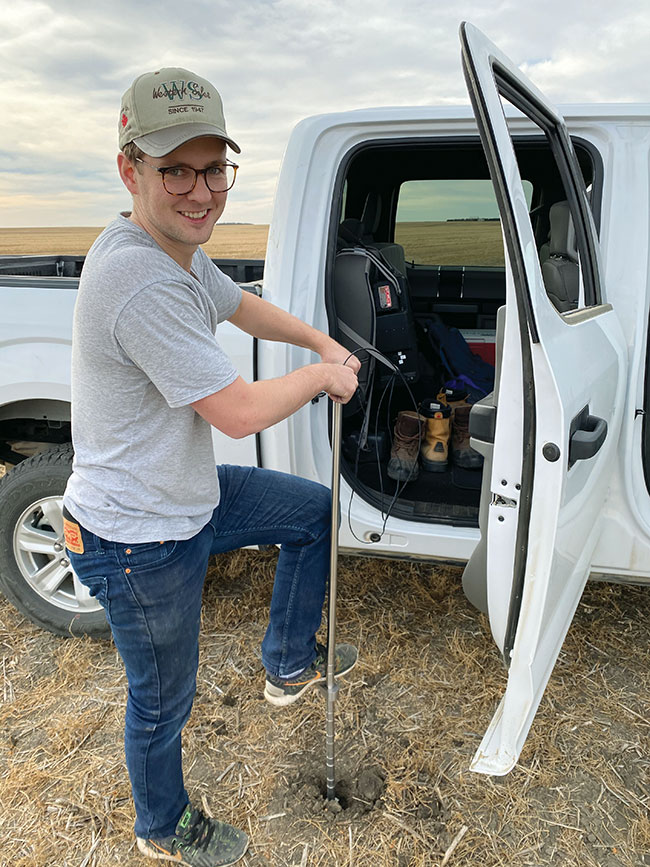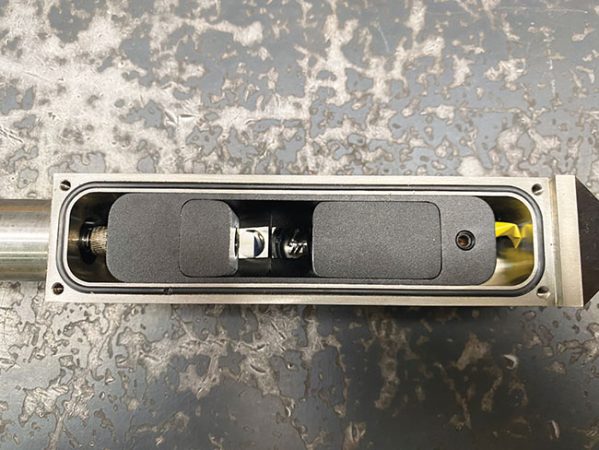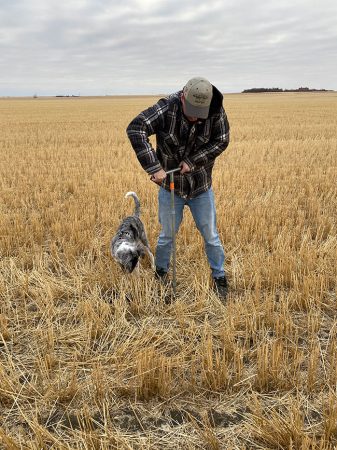
Features
Fertility and Nutrients
Soil
Linking soil NIR measurements, fertility and crop yields
Bringing the benefits of digital ag and big data to Prairie farmers to optimize productivity and profitability.
December 10, 2021 By Donna Fleury
 Field-scale soil NIR sample collection and measurements for the
project.
All photos courtesy of Derek Peak, University of Saskatchewan.
Field-scale soil NIR sample collection and measurements for the
project.
All photos courtesy of Derek Peak, University of Saskatchewan.
Tools for predicting soil productivity and estimating crop yields are improving, but addressing field and soil variability can still be a challenge. Researchers are interested in developing tools that would link soil near infrared (NIR) measurements, fertility and crop yields together with digital agriculture and big data to improve predictability of soil productivity and profitability.
“As a soil chemist, we have been really successful at building soil tests that relate the nutrient status of the soil to plant yields, and coming up with recommended fertilizer blends,” says Derek Peak, professor of soil science at the University of Saskatchewan. “In principle, agronomy does a good job but in practice soil testing is expensive, time-consuming and only provides a snapshot in time of a specific sample location in the field. We are not really doing a good job of capturing the variability you can often see across a field, knowing there are differences in upslope and downslope productivity, water availability, soil organic matter and other variables.
“With the increasing advancements in digital technology, big data and near infrared technology improvements, we are interested in determining if more sophisticated, faster and lower cost ways could be developed to test the productivity of soils.”
Over the past few years, NIR techniques have become more robust, easier to calibrate and less expensive, allowing researchers to use NIR on field-scale collection and analysis of spectra to relate to nutrient status. Although this strategy works well for individual plot research academically, there are challenges to wide-scale use across the Prairies.
To try to address some of those challenges, Peak initiated a three-year project in 2021 to determine if combining NIR spectra collection with digital ag and big data analytics could result in enough data to take advantage of machine learning and artificial intelligence (AI) technology. The project is funded by SaskCanola, Sask Wheat and the Saskatchewan Agriculture Development Fund.

FT-NIR tools in the lab for soil and nutrient analysis.
The objectives are to develop a methodology to link field NIR data and laboratory analyses, and to produce spatially resolved, soil-based yield potential maps. The overarching goal is to help agronomists and farmers use these tools to gain productivity insights and evaluate the likelihood of profitability when investing in inputs for their cropping systems.
“Using an NIR spectra dataset allows researchers to analyze several different soil properties [that are] important for producing crops to provide an overall prediction of yield across the field,” Peak explains. NIR spectroscopy involves the absorption or emission of light over a range of wavelengths to collect spectra.
“There are many interrelated soil properties that influence crop productivity, such as nutrient availability, organic matter, moisture holding capacity, soil texture, and cation exchange capacity. Using NIR, we can analyze and run regressions on all of the variables together and provide an indication of yield potential and realistic yield goals. When combined with big data and AI software tools and algorithms, the ability to predict profitability will be greatly enhanced.
“Ultimately, we want a tool that can evaluate the likelihood that investing inputs and money into a particular field or yield mapped area will result in a profit, rather than just providing a specific fertilizer number.”
Peak has partnered with a company to develop a field probe prototype that would collect the spectra or data at the sample site and then transmit it to the cloud, where big data and AI machine learning could run in the background on servers. Adding more samples to the database further improves the results and predictability. They are on version three of the prototype, which is working well; the bigger challenge is the current cost, at about $10,000 per probe. Although the costs of optics and electronics continue to come down, it is still too costly for every agronomist or farmer to use this individually. So, the project team has pivoted to look at a hub where individual soil samples are currently sent for analysis and make the instrument available there, such as soil test labs or input retails and co-operatives.
“We are partnering with other crop science experts, including university researchers and commercial agronomists, who are already collecting soil samples and doing nutrient analysis to determine yield potential,” Peak adds. “We are working with them to insert our NIR screening technique into their workflow, which helps us get to the millions of spectra that data scientists tell us we need without investing millions of dollars in field trials.
“Using this screening tool, we are able to take tens of thousands of field samples to the lab and measure with NIR. This helps us understand how those samples cluster and behave, and allows us to select samples that make a more scientifically sound study, rather than having to rely on a limited set of samples more typical in classical soil fertility analysis.”
One of the factors that really affects the measurements and AI interpretations is the type of soil sample – whether it is direct from the field or the sample has been dried and ground for testing. Samples at both stages are being compared to develop a calibration method and correction factor to ensure the NIR lab tools using dried samples are able to accurately interpret what is happening in the field.
This technique has broader application beyond the Prairies and Canada. Peak also works internationally in developing countries and regions, such as West Africa, focusing on food security projects. He has encountered even bigger challenges in trying to test soil productivity there, where soil testing labs and capacity were unavailable.

Several soil properties influence crop productivity, including nutrient availability, organic matter and soil texture.
“If we could take a few research sites that have been characterized really well with modern techniques, combined with GIS or some mapping approach for climate, soil, vegetation, elevation and other variables, then we could take that data and scale it out – perhaps even to a regional scale. That would allow agronomists and farmers to compare their soils to the maps and match their fertilizer recommendations to sites that are similar. Although not perfect, this is a really important step towards doing better.”
An important component of the project is the unique training opportunity for students and research associates. Working on the project allows them to learn these advanced techniques, data analysis and computer machine learning applications, while also being able to go out in the field and interact with crop scientists and farmers.
Peak is also a researcher with the university’s Plant Phenotyping and Imaging Research Centre (P2IRC), managed by the Global Institute for Food Security (GIFS), where some of the machine learning and AI computing work will be completed. A complementary graduate student project uses a similar approach, but also includes synchrotron-based spectroscopy work at the
Canadian Light Source (CLS) to compare to NIR.
“Our goal is to have an inexpensive field probe as a tool that every agronomist or farmer could use in the field and get results,” Peak says. “This project is a key intermediate step, combining our NIR technique with building software tools and algorithms and the necessary correction factors to link soil NIR measurements, fertility and crop yields. We will have done all of the upfront painful preliminary work so that, when the technical engineering hurdles are overcome and there is a lowering in price, then the tool is ready to use at a meaningful scale.
“We want the tool to be generally available and useful for those doing soil analysis, and to bring the benefits of digital ag and big data to Prairie farmers for optimizing productivity and profitability.”